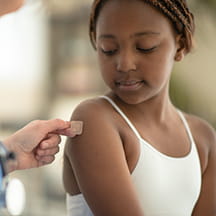One of the biggest—if perhaps less publicized—consequences to arise in the pandemic’s aftermath is the “statistically significant” increase in food insecurity for U.S. children. The USDA reports food insecurity among American households with children rose to nearly 15% in 2020—reversing a decade-long downward trend.
The White House is hosting a conference on hunger, nutrition and health in late September to address this issue, and children’s hospitals figure to play a prominent role in helping to solve the problem.
“Like other children's hospitals, we see this as a very important child's health issue and we're hearing from people firsthand about how it's affecting them,” says Marisha DiCarlo, Ph.D., M.P.H., vice president of Community Engagement, Advocacy, and Health at Arkansas Children's Hospital in Little Rock. “We want to make sure it's at the forefront of our plans, and I know many children's hospitals are going through the same process right now.”
For Arkansas Children’s, that process began with a community health needs assessment of the more than 700,000 children across the state. Among its findings:
- Nearly 23% of children in Arkansas are food insecure.
- One-third of households include children who don’t have enough to eat.
- Arkansas ranks 50th in the nation for food insecurity.
The needs assessment highlighted food insecurity as a primary health care priority for Arkansas Children’s to address in its plans to improve children’s health, including the hospital’s 2023-2025 Community Health Implementation Strategy.
“We've known the effects and have been doing work for some time as a health care system around food security, but it was really profound to see them emerging in a different way this time,” DiCarlo says.
Multiple touchpoints in addressing food security
Key to meeting these challenges, according to DiCarlo, is a combination of internal initiatives and collaborations with external partners. The hospital’s plan includes efforts across three levels of community engagement:
- Individual. Arkansas Children’s provides patients and their families with an optional screening to assess for vulnerabilities around food security and offers access to emergency food supplies, including USDA-provided box lunches and a mobile food pantry on the hospital’s campus.
- Family. The hospital refers families to organizations that can assist with immediate food security needs as well as longer-term programs for which they may qualify, such as Women, Infants and Children (WIC) and Supplemental Nutrition Assistance Program (SNAP). The hospital also partners with local organizations to educate parents on cooking healthy meals on a limited budget.
- Community. In addition to partnerships with community-based referral networks and school-based nutrition education programs, Arkansas Children's hosts a community garden at its main campus. Community volunteers participate in growing and harvesting up to 4,000 pounds of vegetables annually to be distributed to patient families and local food pantries.
Know your role
As integral as food security is to the overall health of children, DiCarlo says it’s crucial to communicate closely with community partners and understand the optimal place for a children’s hospital in these efforts. Though the temptation may be to develop a new or standalone program, often the better path is to leverage the expertise of others.
“Our role is to be a good partner,” DiCarlo says. “What can we bring to the table without it being a replication of something that someone else is already doing well?”
She points to the hospital’s successful partnerships with area food banks as a prime example of this approach. “We are not a food bank, and we won’t ever be one,” DiCarlo says. “But we figure out the best way—from our perspective and theirs—for us to have an impact on this issue affecting children’s health.”



